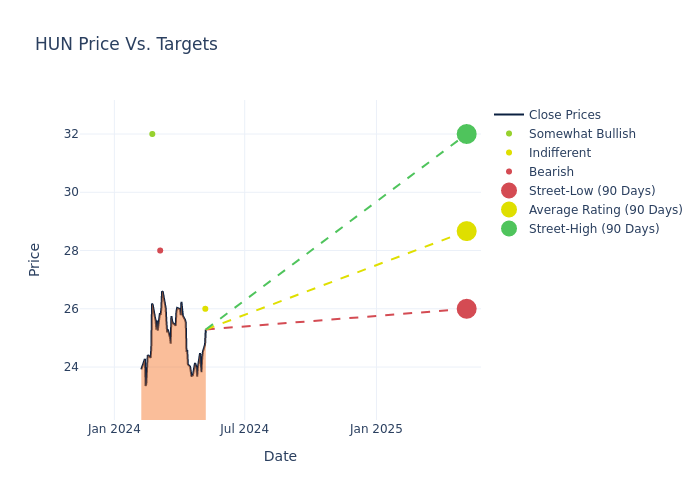Throughout the last three months, 4 analysts have evaluated Huntsman HUN, offering a diverse set of opinions from bullish to bearish.
The table below offers a condensed view of their recent ratings, showcasing the changing sentiments over the past 30 days and comparing them to the preceding months.
| Bullish | Somewhat Bullish | Indifferent | Somewhat Bearish | Bearish | |
|---|---|---|---|---|---|
| Total Ratings | 0 | 1 | 2 | 0 | 1 |
| Last 30D | 0 | 0 | 1 | 0 | 0 |
| 1M Ago | 0 | 0 | 0 | 0 | 0 |
| 2M Ago | 0 | 0 | 0 | 0 | 0 |
| 3M Ago | 0 | 1 | 1 | 0 | 1 |
Providing deeper insights, analysts have established 12-month price targets, indicating an average target of $27.5, along with a high estimate of $32.00 and a low estimate of $24.00. Witnessing a positive shift, the current average has risen by 17.02% from the previous average price target of $23.50.

Deciphering Analyst Ratings: An In-Depth Analysis
In examining recent analyst actions, we gain insights into how financial experts perceive Huntsman. The following summary outlines key analysts, their recent evaluations, and adjustments to ratings and price targets.
| Analyst | Analyst Firm | Action Taken | Rating | Current Price Target | Prior Price Target |
|---|---|---|---|---|---|
| Arun Viswanathan | RBC Capital | Raises | Sector Perform | $26.00 | $24.00 |
| Duffy Fischer | Goldman Sachs | Raises | Sell | $28.00 | $25.00 |
| Michael Sison | Wells Fargo | Raises | Overweight | $32.00 | $25.00 |
| Arun Viswanathan | RBC Capital | Raises | Sector Perform | $24.00 | $20.00 |
Key Insights:
- Action Taken: In response to dynamic market conditions and company performance, analysts update their recommendations. Whether they 'Maintain', 'Raise', or 'Lower' their stance, it signifies their reaction to recent developments related to Huntsman. This insight gives a snapshot of analysts' perspectives on the current state of the company.
- Rating: Providing a comprehensive analysis, analysts offer qualitative assessments, ranging from 'Outperform' to 'Underperform'. These ratings reflect expectations for the relative performance of Huntsman compared to the broader market.
- Price Targets: Analysts provide insights into price targets, offering estimates for the future value of Huntsman's stock. This comparison reveals trends in analysts' expectations over time.
Navigating through these analyst evaluations alongside other financial indicators can contribute to a holistic understanding of Huntsman's market standing. Stay informed and make data-driven decisions with our Ratings Table.
Stay up to date on Huntsman analyst ratings.
All You Need to Know About Huntsman
Huntsman Corp is a us-based manufacturer of differentiated organic chemical products. Its product portfolio comprises Methyl diphenyl diisocyanate (MDI), Amines, Maleic anhydride, and Epoxy-based polymer formulations. The company's products are used in adhesives, aerospace, automotive, and construction products, among others. Its operating segments are Polyurethanes, Performance Products, and Advanced Materials. It derives most of its revenue from the Polyurethanes segment which includes MDI, polyols, TPU (thermoplastic polyurethane), and other polyurethane-related products. Its geographical segments are the United States & Canada, Europe, Asia-Pacific, and the Rest of the world.
Huntsman's Financial Performance
Market Capitalization Analysis: The company's market capitalization is below the industry average, suggesting that it is relatively smaller compared to peers. This could be due to various factors, including perceived growth potential or operational scale.
Negative Revenue Trend: Examining Huntsman's financials over 3 months reveals challenges. As of 31 March, 2024, the company experienced a decline of approximately -8.47% in revenue growth, reflecting a decrease in top-line earnings. In comparison to its industry peers, the company trails behind with a growth rate lower than the average among peers in the Materials sector.
Net Margin: Huntsman's financial strength is reflected in its exceptional net margin, which exceeds industry averages. With a remarkable net margin of -2.52%, the company showcases strong profitability and effective cost management.
Return on Equity (ROE): Huntsman's ROE falls below industry averages, indicating challenges in efficiently using equity capital. With an ROE of -1.16%, the company may face hurdles in generating optimal returns for shareholders.
Return on Assets (ROA): Huntsman's ROA is below industry standards, pointing towards difficulties in efficiently utilizing assets. With an ROA of -0.5%, the company may encounter challenges in delivering satisfactory returns from its assets.
Debt Management: Huntsman's debt-to-equity ratio is below the industry average. With a ratio of 0.79, the company relies less on debt financing, maintaining a healthier balance between debt and equity, which can be viewed positively by investors.
The Basics of Analyst Ratings
Analysts are specialists within banking and financial systems that typically report for specific stocks or within defined sectors. These people research company financial statements, sit in conference calls and meetings, and speak with relevant insiders to determine what are known as analyst ratings for stocks. Typically, analysts will rate each stock once a quarter.
Analysts may enhance their evaluations by incorporating forecasts for metrics like growth estimates, earnings, and revenue, delivering additional guidance to investors. It is vital to acknowledge that, although experts in stocks and sectors, analysts are human and express their opinions when providing insights.
This article was generated by Benzinga's automated content engine and reviewed by an editor.
Edge Rankings
Price Trend
© 2025 Benzinga.com. Benzinga does not provide investment advice. All rights reserved.
date | ticker | name | Price Target | Upside/Downside | Recommendation | Firm |
|---|
Trade confidently with insights and alerts from analyst ratings, free reports and breaking news that affects the stocks you care about.